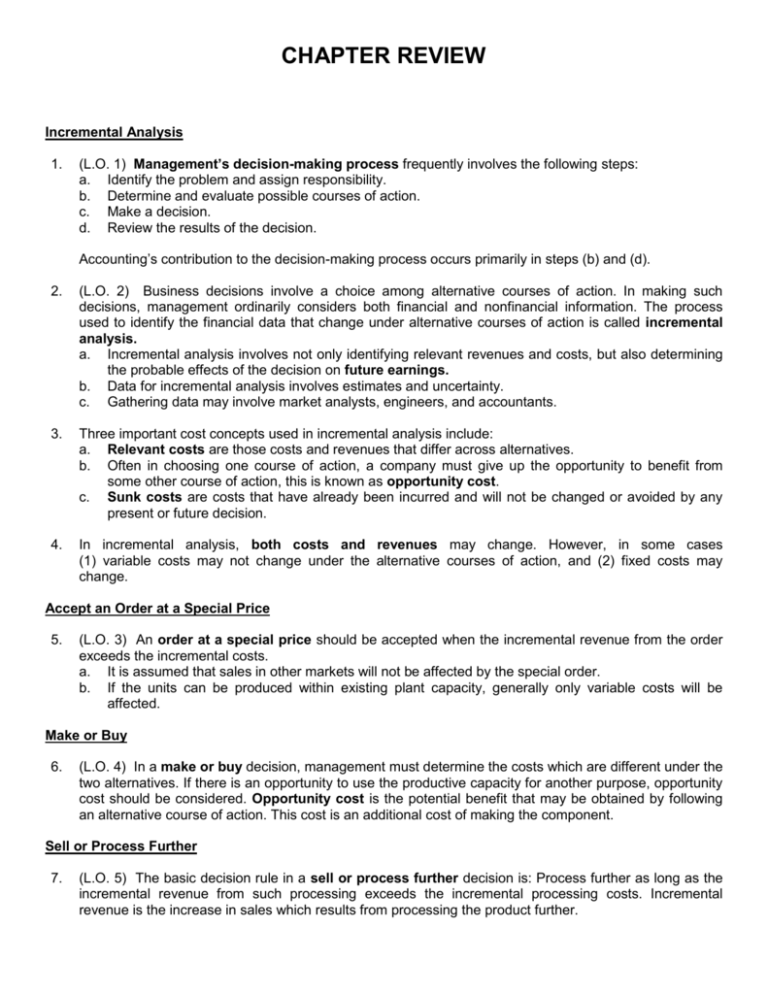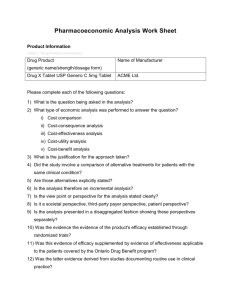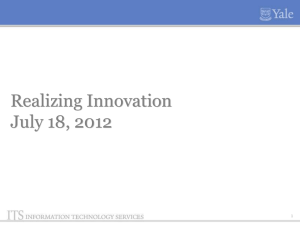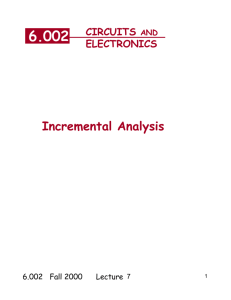File
advertisement

CHAPTER REVIEW Incremental Analysis 1. (L.O. 1) Management’s decision-making process frequently involves the following steps: a. Identify the problem and assign responsibility. b. Determine and evaluate possible courses of action. c. Make a decision. d. Review the results of the decision. Accounting’s contribution to the decision-making process occurs primarily in steps (b) and (d). 2. (L.O. 2) Business decisions involve a choice among alternative courses of action. In making such decisions, management ordinarily considers both financial and nonfinancial information. The process used to identify the financial data that change under alternative courses of action is called incremental analysis. a. Incremental analysis involves not only identifying relevant revenues and costs, but also determining the probable effects of the decision on future earnings. b. Data for incremental analysis involves estimates and uncertainty. c. Gathering data may involve market analysts, engineers, and accountants. 3. Three important cost concepts used in incremental analysis include: a. Relevant costs are those costs and revenues that differ across alternatives. b. Often in choosing one course of action, a company must give up the opportunity to benefit from some other course of action, this is known as opportunity cost. c. Sunk costs are costs that have already been incurred and will not be changed or avoided by any present or future decision. 4. In incremental analysis, both costs and revenues may change. However, in some cases (1) variable costs may not change under the alternative courses of action, and (2) fixed costs may change. Accept an Order at a Special Price 5. (L.O. 3) An order at a special price should be accepted when the incremental revenue from the order exceeds the incremental costs. a. It is assumed that sales in other markets will not be affected by the special order. b. If the units can be produced within existing plant capacity, generally only variable costs will be affected. Make or Buy 6. (L.O. 4) In a make or buy decision, management must determine the costs which are different under the two alternatives. If there is an opportunity to use the productive capacity for another purpose, opportunity cost should be considered. Opportunity cost is the potential benefit that may be obtained by following an alternative course of action. This cost is an additional cost of making the component. Sell or Process Further 7. (L.O. 5) The basic decision rule in a sell or process further decision is: Process further as long as the incremental revenue from such processing exceeds the incremental processing costs. Incremental revenue is the increase in sales which results from processing the product further. 8. Sell-or-process-further decisions are particularly applicable to production processes that produce multiple products simultaneously. In these types of decisions, all costs incurred prior to the point at which the joint products are separately identifiable (the split-off point) are called joint costs. Joint product costs are sunk costs. Repair, Retain or Replace Equipment 9. (L.O. 6) In a decision to retain or replace equipment, management compares the costs which are affected by the two alternatives. Generally, these are variable manufacturing costs and the cost of the new equipment. a. The book value of the old machine is a sunk cost which does not affect the decision. b. However, any trade-in allowance or cash disposal value of the existing asset must be considered. Eliminate an Unprofitable Segment or Product 10. (L.O. 7) In deciding whether to eliminate an unprofitable segment, management should choose the alternative which results in the highest net income. Often fixed costs allocated to the unprofitable segment must be absorbed by the other segments. It is possible, therefore, for net income to decrease when what appears to be an unprofitable segment is eliminated. 11. Many of the decisions involving incremental analysis also have important qualitative features. SOLUTIONS TO BRIEF EXERCISES BRIEF EXERCISE 7-1 The correct order is: 1. 2. 3. 4. Identify the problem and assign responsibility. Determine and evaluate possible courses of action. Make a decision. Review results of the decision. BRIEF EXERCISE 7-2 Revenues Costs Net income Alternative A $160,000 100,000 $ 60,000 Alternative A is better than Alternative B. Alternative B $180,000 125,000 $ 55,000 Net Income Increase (Decrease) ($ 20,000) (25,000) ($ 5,000) BRIEF EXERCISE 7-3 Revenues Costs—Variable manufacturing Shipping Net income Reject Order $0 0 0 $0 The special order should be accepted. *3,000 X $25 **3,000 X $20 ***3,000 X $ 2 Accept Order $75,000* 60,000** 6,000*** $ 9,000 Net Income Increase (Decrease) ($ 75,000) ( (60,000) ( (6,000) ($ 9,000) BRIEF EXERCISE 7-4 Variable manufacturing costs Fixed manufacturing costs Purchase price Total annual cost Make $50,000 30,000 –0– $80,000 Buy $ –0– 30,000 60,000 $90,000 Net Income Increase (Decrease) $ 50,000 0 (60,000) ($(10,000) The decision should be to make the part. BRIEF EXERCISE 7-5 Sales price per unit Cost per unit Variable Fixed Total Net income per unit Sell $62.00 Process Further $70.00 Net Income Increase (Decrease) $8.00 36.00 10.00 46.00 $16.00 43.00 10.00 53.00 $17.00 ( (7.00) 0 ( (7.00) $1.00 The bookcases should be processed further because the incremental revenues exceed incremental costs by $1.00 per unit. BRIEF EXERCISE 7-6 The allocated joint costs are irrelevant to the sell or process further decisions. If AB1 is processed further, the company will earn incremental revenue of $50,000 ($150,000 – $100,000) and only incur incremental costs of $45,000. Therefore, the company should process AB1 further and sell AB2. If XY1 is processed further, the company will earn incremental revenue of $35,000 ($130,000 – $95,000) but will incur incremental costs of $50,000. Therefore, the company should sell XY1 rather than process it further. BRIEF EXERCISE 7-7 Variable manufacturing costs for 4 years New machine cost Sell old machine Total Retain Equipment Replace Equipment Net 4-Year Income Increase (Decrease) $3,000,000 (30,000) $2,500,000 300,000 (30,000) $2,770,000 ($ 500,000 ((300,000) 30,000 $ 230,000 $3,000,000 The old factory machine should be replaced. BRIEF EXERCISE 7-8 Sales Variable costs Contribution margin Fixed costs Net income Continue $200,000 180,000 20,000 30,000 ($ (10,000) Eliminate $ –0– –0– ( –0– 20,000) $(20,000) Net Income Increase (Decrease) $(200,000) (180,000) (20,000) ( 10,000) $ (10,000) The Big Bart product line should be continued because $20,000 of contribution margin will not be realized if the line is eliminated. This amount is greater than the $10,000 savings of fixed costs. SOLUTIONS TO PROBLEMS PROBLEM 7-1A (a) Revenues (10,000 X $27) Cost of goods sold Selling and administrative expenses Net income Reject Order $0 0 Accept Order $270,000 220,000 (1) Net Income Increase (Decrease) $ 270,000 ( (220,000) 0 $0 20,000 (2) $ 30,000 ( (20,000) $ 30,000 (1) Variable costs = $3,600,000 – $960,000 = $2,640,000; $2,640,000 ÷ 120,000 units = $22.00 per unit; 10,000 X $22.00 = $220,000. (2) Variable costs = $405,000 – $225,000 = $180,000; $180,000 ÷ 120,000 units = $1.50 per unit; 10,000 X ($1.50 + $0.50) = $20,000. (b) Yes, the special order should be accepted because net income will increase by $30,000. (c) Unit selling price = $22.00 (variable manufacturing costs) + $2.00 variable selling and administrative expenses + $4.00 net income = $28. (d) Nonfinancial factors to be considered are: (1) possible effect on domestic sales, (2) possible alternative uses of the unused plant capacity, and (3) ability to meet customer’s schedule for delivery without increasing costs. PROBLEM 7-2A (a) Make CISCO Direct materials (8,000 X $4.80) Direct labor (8,000 X $4.30) Indirect labor (8,000 X $.43) Utilities (8,000 X $.40) Depreciation Property taxes Insurance Purchase price Freight and inspection (8,000 X $.35) Receiving costs Total annual cost $38,400 Buy CISCO $ Net Income Increase (Decrease) 0 ($38,400) 34,400 0 ( 34,400) 3,440 3,200 3,000 700 1,500 0 0 0 900 200 600 80,000 ( 3,440) ( 3,200) ( 2,100) ( 500) ( 900) ( (80,000) 0 0 $84,640 2,800 1,300 $85,800 ( (2,800) ( (1,300) ($ (1,160) (b) The company should continue to make CISCO because net income would be $1,160 less if CISCO were purchased from the supplier. (c) The decision would be different. Because of the opportunity cost of $3,000, net income will be $1,840 higher if CISCO is purchased as shown below: Net Income Increase Make CISCO Buy CISCO (Decrease) Total annual cost $84,640 $85,800 $(1,160) Opportunity cost 3,000 0 (3,000) Total cost $87,640 $85,800 $(1,840) (d) Nonfinancial factors include: (1) the adverse effect on employees if CISCO is purchased, (2) how long the supplier will be able to satisfy the Shatner Manufacturing Company’s quality control standards at the quoted price per unit, and (3) whether the supplier will deliver the units when they are needed by Shatner. PROBLEM 7-3A (a) (1) Table Cleaner Not Processed Further Sales: FloorShine (600,000 ÷ 30) X $20 Table Cleaner (300,000 ÷ 25) X $18 Total revenue Costs: CDG Additional costs of FloorShine Total costs Gross profit (2) $400,000 216,000 $616,000 210,000 240,000 450,000 $166,000 Table Cleaner Processed Further Sales: FloorShine Table Stain Remover (300,000 ÷ 25) X $14 Table Polish (300,000 ÷ 25) X $14 Total revenue Costs: CDG Additional costs of FloorShine TCP Total costs Gross profit $400,000 168,000 168,000 $736,000 210,000 240,000 100,000 550,000 $186,000 (3) If the table cleaner is processed further overall company profits will be $20,000 higher. Therefore, management made the wrong decision by choosing to not process table cleaner further. PROBLEM 7-3A (Continued) (b) Incremental revenue Incremental costs Totals Don’t Process Table Cleaner Further $216,000 0 $216,000 Process Table Cleaner Further $336,000 100,000 $236,000 Net Income Increase (Decrease) $120,000 (100,000) $ 20,000 When trying to decide if the table cleaner should be processed further into TSR and TP, only the relevant data need be considered. All of the costs that occurred prior to the creation of the table cleaner are sunk costs and can be ignored. The decision should be made by comparing the incremental revenue from further processing to the incremental costs. PROBLEM 7-4A (a) Cost Accumulated depreciation Book value Sales proceeds Loss on sale $120,000 (24,000*) 96,000 (25,000) $ 71,000 *$120,000 ÷ 5 years = $24,000 (b) (1) Revenues ($240,000 X 4 yrs.) Less costs: Variable costs ($35,000 X 4) Fixed costs ($23,000 X 4) Selling & administrative Depreciation Net income Retain Old Elevator $960,000 $140,000 92,000 116,000* 96,000 444,000 $516,000 *($29,000 X 4) (2) Revenues Less costs: Variable costs ($10,000 X 4) Fixed costs ($8,500 X 4) Selling and administrative Depreciation Operating income Less: Loss on old elevator Net income Replace Old Elevator $960,000 $ 40,000 34,000 116,000 160,000 350,000 610,000 71,000 $539,000 (c) Variable operating costs Fixed operating costs New elevator cost Salvage on old elevator Totals Retain Replace Old Elevator Old Elevator $140,000 $ 40,000 92,000 34,000 160,000 (25,000) $232,000 $209,000 . Net Income Increase (Decrease) $ 100,000 58,000 (160,000) 25,000 $ 23,000 PROBLEM 7-4A (Continued) (d) MEMO TO: Ron Richter FROM: Student SUBJECT: Relevant Data for Decision to Replace Old Elevator When deciding whether or not to replace any old equipment, the analysis should only include cost data relevant to the replacement decision. The $71,000 loss that would be experienced if we replace the old elevator with the newer model is related to a sunk cost, namely the cost of the old elevator. Sunk costs are irrelevant in decision making. The loss occurs when comparing the book value of the old elevator to the cash proceeds that would be received. The book value of $96,000 would be deducted as depreciation expense over the next four years if the elevator were retained. If the elevator is replaced with the newer model, the book value will be expensed in the current year, less the cash proceeds received on disposal. Therefore, the $96,000 book value will be expensed under either alternative, making it irrelevant. PROBLEM 7-5A (a) Sales Variable costs Cost of goods sold Selling and administrative Total variable expenses Contribution margin Division I $250,000 Division II $200,000 150,000 30,000 180,000 ($ 70,000) 172,800 42,000 214,800 $ (14,800) (b) (1) Net Income Increase (Decrease) Division I Continue Eliminate Contribution margin (above) Fixed costs Cost of goods sold Selling and administrative Total fixed expenses Income (loss) from operations $(70,000) $( 0) $(70,000) (50,000) (45,000) (95,000) $(25,000) (25,000) (22,500) (47,500) $(47,500) 25,000 22,500 47,500 $(22,500) Net Income Increase (Decrease) (2) Division II Continue Eliminate Contribution margin (above) Fixed costs Cost of goods sold Selling and administrative Total fixed expenses Income (loss) from operations $(14,800) $( 0) $14,800 (19,200 ( 18,000 ( 37,200 $(52,000) ( 9,600) ( 9,000) (18,600) $(18,600) ( 9,600 9,000 18,600 $33,400 Division II should be eliminated as its negative contribution margin is $14,800. Income from operations would increase $33,400 if Division II is eliminated. Division I should be continued because it is producing positive contribution margin of $70,000. Income from operations will decrease $22,500 by discontinuing this division. PROBLEM 7-5A (Continued) (c) GUTIERREZ COMPANY CVP Income Statement For the Quarter Ended March 31, 2014 Divisions Sales Variable costs Cost of goods sold Selling and administrative Total variable costs Contribution margin Fixed costs Cost of goods sold (1) Selling and administrative (2) Total fixed costs Income (loss) from operations I III IV Total $250,000 $500,000 $450,000 $1,200,000 150,000 240,000 187,500 577,500 30,000 30,000 30,000 90,000 180,000 70,000 270,000 230,000 217,500 232,500 667,500 532,500 53,200 63,200 65,700 182,100 48,000 33,000 23,000 104,000 101,200 96,200 88,700 286,100 $(31,200) $133,800 $143,800 $ 246,400 (1) Division’s fixed cost of goods sold plus 1/3 of Division II’s unavoidable fixed cost of goods sold [$192,000 X (100% – 90%) X 50% = $9,600]. Each division’s share is $3,200. (2) Division’s fixed selling and administrative expense plus 1/3 of Division II’s unavoidable fixed selling and administrative expenses [$60,000 X (100% – 70%) X 50% = $9,000]. Each division’s share is $3,000. (d) Income from operations with Division II of $213,000 (given) plus incremental income of $33,400 from eliminating Division II = $246,400 income from operations without Division II.




